
La Earthcache / The Earthcache
► Le site d'observation : L'Eglise de Sainte-Radegonde
L'Eglise de Sainte-Radegonde prend place au sein de l'ancienne cité fortifiée de Talmont sur Gironde sise sur un promontoire d'un ancien îlot calcaire surplombant l'estuaire de la Gironde.
Batie au XIIIème siècle, elle mélange un style roman d'origine avec une partie gothique mise en place dans sa partie nord suite à un effondrement d'une partie de l'édifice dans l'estuaire.
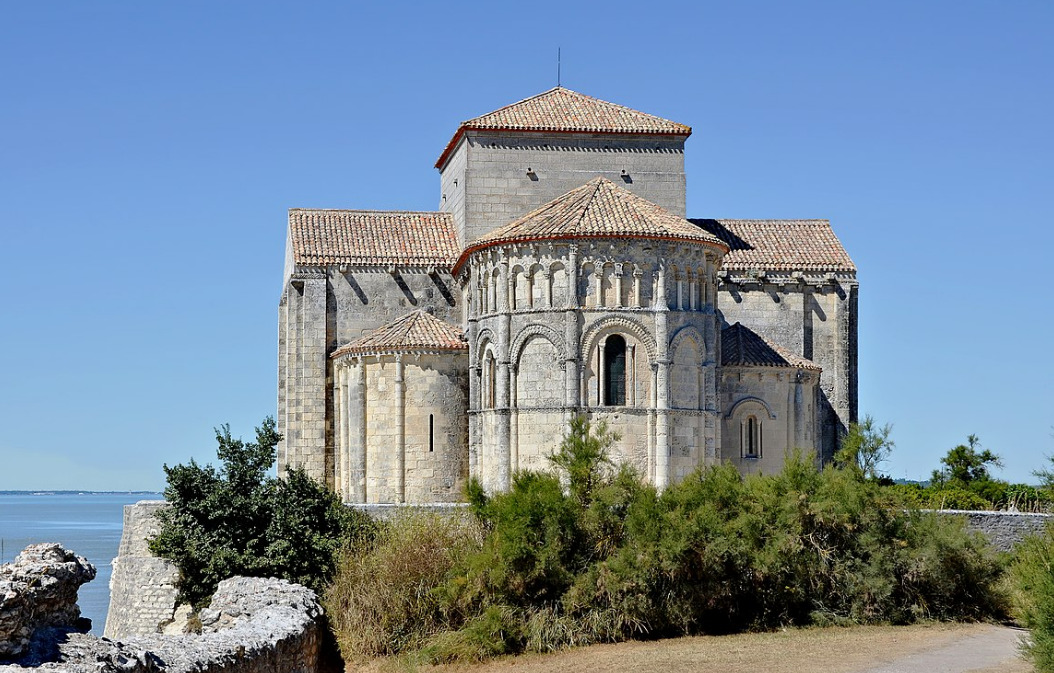
Elle a été édifiée à partir de matériels géologiques locaux, des formations sédimentaires calcaires du Crétacé supérieur (Maastrichtien et Campanien) mises en place il y a 70 millions d'années.
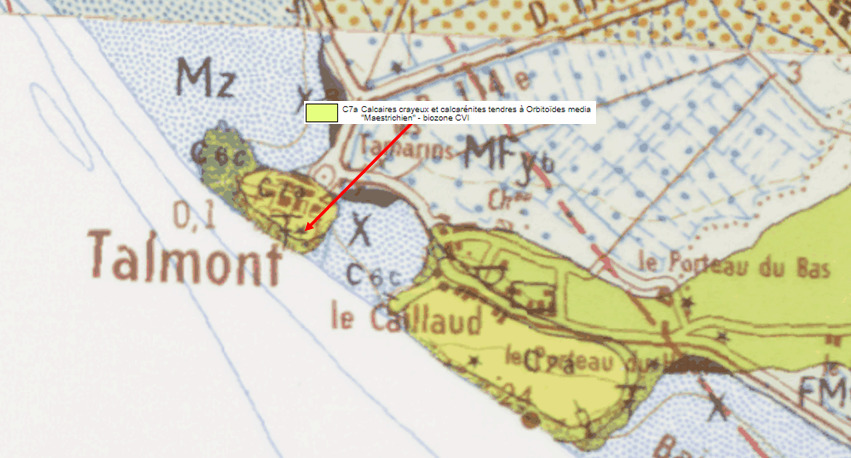
► Les calcaires du Crétacé
Ces calcaires ont été déposés par la mer un peu avant la fin du Secondaire alors qu’elle découvrait progressivement la bordure nord du Bassin d’Aquitaine.
Pour rappel, les calcaires sont des roches sédimentaires, tout comme les grès ou les gypses.
Roches tendre de couleur claire (blanc ou jaune généralement) elles sont facilement solubles dans l'eau, composées majoritairement de carbonate de calcium CaCO3 mais aussi de carbonate de magnésium MgCO3.

La calcaires crayo-marneux avec une forte teneur en carbonate de calcium (environ 75%) est une formation facile à travailler, mais ce qui en fait une qualité d'exploitation est également un faiblesse.
C'est en effet une roche tendre, ce qui la rend particulièrement sensible à l'altération atmosphérique.
Étudions ses formes d'altérations dont les caractéristiques résultent des propriétés physico-chimiques de la roche et de son environnement à l'air libre.
► Les facteurs d'altération d'une roche calcaire
Au contact de l'air atmosphérique et des éléments, de nombreux mécanismes de dégradation de la roche calcaire se mettent en place.
Les origines des altérations sont de plusieurs natures :
- L'eau est le principal agent de dégradation de la pierre. Son action peut être aggravée par l'effet de l'air. L'eau s'attaque à la pierre sous forme d'eau de pluie, de ruissellement, de remontée capillaire.
- Le gaz carbonique, dissous dans l'eau, présente également un rôle de dissolution chimique du carbonate de calcium composant le calcaire.
- Le développement de micro-organismes et de végétaux (lichens, algues, mousses, champignons), dont les sécrétions acides dissolvent également le CaCO3.
- Le sel, qui entraîne une forme particulière d'altération appelée haloclastie donnant à la roche des formes alvéolaires. Ces alvéoles, regroupées sous la forme de Nids d'abeilles (HoneyCoumb), ont comme caractéristique de se creuser en profondeur puis vers le haut.
- Le gel/dégel qui peuvent faire éclater la pierre selon la porosité du matériau.
► Les types d'altérations du calcaire
Ils sont de sont de trois natures :
- la desquamation : la pierre se désagrège en plaques, la couche inférieure devenant sableuse.
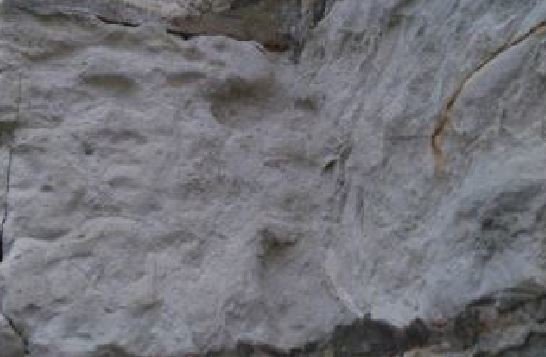
- la pulvérulence : la pierre se désagrège en poussière/grains de sable.
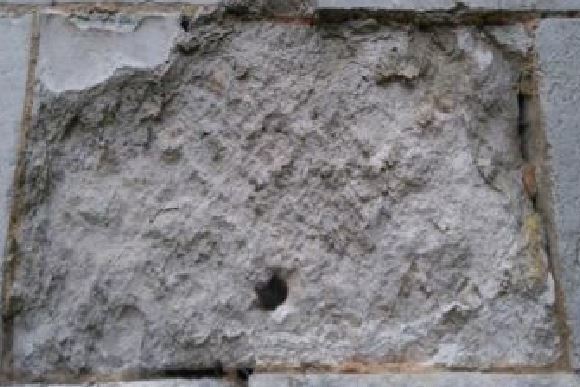
- l'alvéolisation / haloclastie : la pierre présente des cavités profondément rongées telle un gruyère ; cette forme d'altération est caractéristique du phénomène d'haloclastie expliquée ci-dessus.

► Le principe d'altération différentielle
L'intensité de l'altération sur une roche calcaire dépend de sa nature et de ses caractéristiques physiques, principalement la dureté et la porosité des éléments qui composent ce calcaire.
Le calcaire du Crétacé supérieur à Talmont sur Gironde présente une composition variable entre la partie calcaire et la partie marneuse, ceux qui va faire varier sa dureté et sa résistance à l'érosion ; Plus la proportion de marne sera élevé, plus le calcaire sera fragile.
Par ailleurs, la présence de fossiles calcaires durs, de clastes détritiques (grains d'autres formations rocheuses) ou de calcin (induration du carbonate de calcium en surface au contact du CO2 atmosphérique) peuvent également impacter cette sensibilité en créant une couche protectrice sur le calcaire.
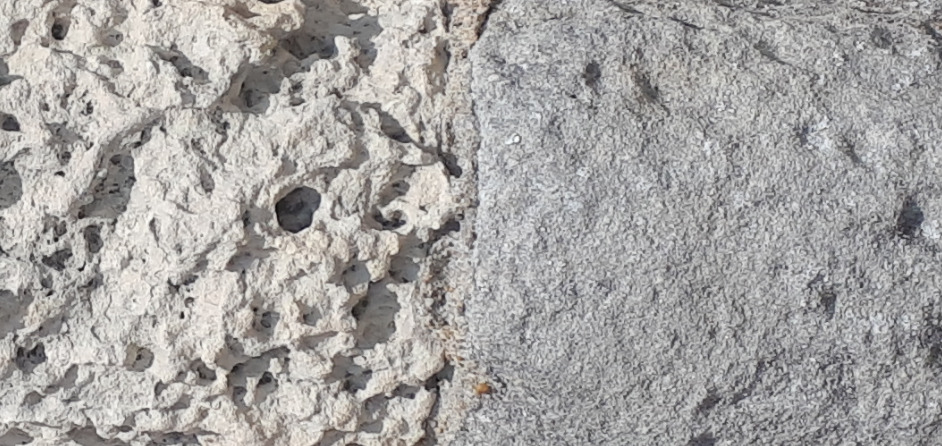
► The site of observation: The Church of Sainte-Radegonde
The Church of Sainte-Radegonde takes place in the old fortified city of Talmont sur Gironde located on a promontory of an old limestone islet overlooking the Gironde estuary.
Built in the 13th century, it mixes an original Romanesque style with a Gothic part set up in its northern part following a collapse of part of the building in the estuary.
It was built from local geological materials, limestone sedimentary formations of the Upper Cretaceous (Maastrichtian and Campanian) established 70 million years ago.
► Cretaceous limestones
These limestones were deposited by the sea a little before the end of the Secondary when it gradually discovered the northern edge of the Aquitaine Basin.
As a reminder, limestones are sedimentary rocks, just like sandstone or gypsum.
Soft, light-colored rocks (generally white or yellow), they are easily soluble in water, mainly composed of calcium carbonate CaCO3 but also of magnesium carbonate MgCO3.
The chalky-marly limestones with a high content of calcium carbonate (about 75%) is an easy-to-work formation, but what makes it an operating quality is also a weakness.
It is indeed a soft rock, which makes it particularly sensitive to atmospheric weathering.
Let us study its forms of alteration whose characteristics result from the physico-chemical properties of the rock and its environment in the open air.
► The alteration factors of a limestone rock
In contact with the atmospheric air and the elements, many mechanisms of degradation of the limestone rock are put in place.
The origins of the alterations are of several kinds:
- Water is the main agent of degradation of the stone. Its action can be aggravated by the effect of air. The water attacks the stone in the form of rainwater, runoff, water vapor, capillary rise.
- Carbon dioxide, dissolved in water, also has a role of chemical dissolution of the calcium carbonate composing the limestone.
- The development of microorganisms and plants (lichens, algae, mosses, fungi), whose acidic secretions also dissolve CaCO3.
- Salt, which causes a particular form of alteration called haloclasty giving the rock alveolar forms. These cells, grouped in the form of Honeycombs (HoneyCoumb), have the characteristic of digging deep and then upwards.
- The freeze / thaw that can break the stone according to the porometry of the material (ability of the pores to store and reject water).
► Types of limestone alterations
They are of three natures:
- desquamation: the stone breaks up into slabs, the lower layer becoming sandy.
- powderiness: the stone breaks up into dust / grains of sand.
- the alveolization / haloclastic: the stone presents cavities (deeply eaten like a Swiss cheese); this form of alteration is characteristic of the haloclastic phenomenon explained above.
► The principle of differential alteration
The intensity of weathering on a limestone rock depends on its nature and physical characteristics, mainly the hardness and porosity of the elements that make up this limestone.
The upper Cretaceous limestone at Talmont sur Gironde has a variable composition between the limestone part and the marly part, those which will vary its hardness and its resistance to erosion; The higher the proportion of marl, the more fragile the limestone will be.
In addition, the presence of hard limestone fossils, detrital clasts (grains of other rock formations) or cullet (induration of calcium carbonate on the surface in contact with atmospheric CO2) can also impact this sensitivity by creating a protective layer on the limestone.
► Sources bibliographiques / Bibliographical sources
Les Questions / The Questions
La lecture attentive du descriptif de la cache, ainsi qu'une observation des éléments de terrain et un peu de déduction sont normalement suffisants pour répondre aux questions de cette EarthCache.
A careful reading of the description of the cache, as well as observation of terrain features and some deduction is usually sufficient to answer questions of this EarthCache.
Questions pour valider :"Altération à Sainte-Radegonde"
Questions to validate: "Alteration in Sainte-Radegonde"
- Question 0 : Prenez une photo de vous ou d'un élément vous identifiant avec l'église ou la Gironde en arrière plan (mais pas de photo des WP1 ou WP2).
Cette photo devra au choix nous être transmise avec les réponses ou être ajoutée à votre log.
-Question 0 : Take a photo of yourself or something identifying you with the church or the Gironde in the background (but no photo of WP1 or WP2).
This photo must either be sent to us with the answers or added to your log.
Point 1 : N 45° 32.081 W 000° 54.548
Vous voici devant l'entrée Nord de l'église Sainte-Radegonde, sur la facade exposée au Nord/Nord_Est. Étudions l'altération des colonnes de droite sous la zone rouge (photo WP1).
Here you are in front of the North entrance of the Sainte-Radegonde church, on the facade exposed to the North / North_Est. Let us study the alteration of the right columns under the red zone (photo WP1).

- Question 1 : Décrire la roche (couleur, granularité, présence de fossiles). Quelle est sa nature ?
- Question 1 : Describe the rock (color, granularity, presence of fossils). What is its nature ?
- Question 2 : Décrire la forme d'altération prédominante sous la zone rouge. A quoi ces formes altérées vous font-elles penser ? Quel est le principal agent en cause dans ce mécanisme d'altération ? Cela vous semble t-il cohérent avec la position géographique de Talmont sur Gironde ?
- Question 2 : Describe the predominant form of weathering under the red area. What do these altered forms make you think of? What is the main agent involved in this alteration mechanism? Does this seem consistent with the geographic position of Talmont sur Gironde?
- Question 3 : Observez de plus près l'intérieur des zones d'altération. Ces parois internes sont-elles régulières et lisses ? Pourquoi ?
- Question 3 : Take a closer look inside the weathering zones. Are they regular and homogeneous? Why ?
Point 2 : N 45° 32.068 W 000° 54.545
Contournez l'église jusqu'à son mur exposé Sud/Sud-Est. Observez les zones bleues et jaunes de la photo WP2.
Go around the church to its south / south-east facing wall. Observe the blue and yellow areas of the WP2 photo.
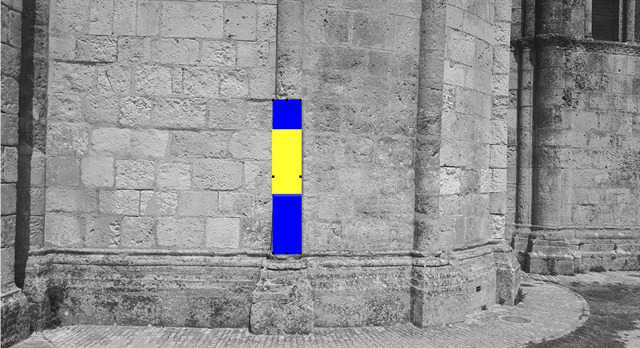
- Question 4 : Les deux zones bleues et jaunes ont-elle le même niveau d'altération ? Justifiez votre réponse en en proposant une explication.
- Question 4 : Do both blue and yellow areas have the same level of weathering? Justify your answer by offering an explanation.
Vous pouvez vous loguer sans attendre notre confirmation,
mais vous devez nous envoyer les réponses en même temps soit par mail via notre profil (
fafahakkai), soit via la messagerie geocaching.com (Message Center).
S'il y a des problèmes avec vos réponses nous vous en ferons part.
Les logs enregistrés sans réponses seront supprimés.Une photo de vous ou de votre GPS avec l’église monolithe de Saint Emilion (hors WP) arrière plan est la bienvenue, mais n'est pas obligatoire.
You can log this cache without waiting for our confirmation, but you must send us the answers at the same time, by e-mail via our profile (fafahakkai) or by the system of Message Center of geocaching.com.
If there is a problem with your answers we will notify you. The logs recorded without answers will be deleted.
A photo of you or your GPS with the monolithic church of Saint Emilion (excluding WP) background is welcome, but not mandatory.
Rappel concernant les « Earthcaches »: Il n'y a pas de conteneur à rechercher ni de logbook à renseigner. Il suffit de se rendre sur les lieux, de répondre aux questions ci-dessus et de nous renvoyer les réponses.
Reminder concerning "Earthcaches": there is neither a container to look for nor a logbook to sign. One need only go to the location, answer to the differents questions and send us the answers.